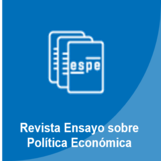Recent Submissions
Open Access

Reporte de Mercados Financieros - Segundo trimestre de 2024
(Banco de la República) Vargas-Herrera, Hernando; Murcia-Pabón, Andrés; Cabrera-Rodríguez, Wilmar Alexander; Martínez-Cruz, Diego Alejandro; Murillo-Ariza, Sara; Barreto-Ramírez, Ittza Alejandra; Botero-Ramírez, Oscar David; León-Díaz, Laura Viviana; Mateus-Gamboa, Julián Camilo; Orozco-Vanegas, Camilo; Ruiz-Cardozo, Cristhian Hernando; Duarte-García, Andrés Felipe; Tovar-Jiménez, Julián David
Durante el segundo trimestre del año, los indicadores de inflación superaron las expectativas del mercado en las principales economías desarrolladas y se mantuvieron por encima de las metas de sus respectivos bancos centrales. Al mismo tiempo, la actividad económica continuó mostrando resiliencia. En este contexto, los responsables de política adoptaron una postura cautelosa con relación a los ajustes de las tasas de política monetaria (TPM), lo que llevó al mercado a anticipar TPM altas por un periodo más prolongado. En consecuencia, la deuda pública de la mayoría de los países, incluidos los bonos del gobierno de Colombia (TES), presentó desvalorizaciones.
Los indicadores de inflación sorprendieron al alza y se mantienen por encima de las metas de la mayoría de los bancos centrales.
Los principales bancos centrales de economías desarrolladas mantuvieron una postura cautelosa, contribuyendo a las expectativas de una política monetaria contractiva por un periodo más prolongado.
Los activos de renta fija en la mayoría de los países se desvalorizaron, en línea con el ajuste en las expectativas sobre las TPM.
Los bancos centrales de algunos países de la región (Brasil, Chile y Perú) continuaron con los recortes de sus TPM, aunque el ritmo de estos recortes disminuyó, alineándose con los menores recortes esperados en economías desarrolladas y algunos datos de actividad económica que sorprendieron al alza al mercado.
Durante el segundo trimestre de 2024, la actividad económica global mostró resiliencia, aunque hacia el final del periodo se observaron señales de desaceleración. La percepción de riesgo a nivel global se mantuvo en niveles bajos, a pesar de algunos eventos de riesgo.
La actividad económica continuó sorprendiendo favorablemente al mercado, destacando el buen desempeño del mercado laboral y de los indicadores líderes manufactureros y de servicios a nivel global, lo cual mejoró las perspectivas de crecimiento económico.
Sin embargo, el entorno internacional estuvo marcado por la incertidumbre en torno a los conflictos comerciales y geopolíticos, los próximos comicios en varias economías desarrolladas y las preocupaciones sobre el panorama fiscal en estas economías.
Los indicadores de percepción de riesgo hacia economías emergentes aumentaron, mientras se observó una moderación del apetito por activos de estas economías.
A nivel local, la Junta Directiva del Banco de la República recortó la TPM en 100 puntos básicos, ubicándola en 11,25 % al cierre del trimestre. Los activos de renta fija se desvalorizaron en consonancia con lo observado a nivel global.
Los TES se desvalorizaron en línea con los títulos de renta fija de otros países de la región. Además de los factores externos, esta desvalorización incorporó la incertidumbre en el frente fiscal.
La percepción de riesgo a nivel local aumentó, en línea con lo observado en otras economías emergentes y la incertidumbre local.
Los fondos de pensiones y cesantías (FPC) y los inversionistas extranjeros continuaron comprando TES, especialmente en el tramo largo. No obstante, se observó una moderación en las compras de los FPC frente a lo registrado en el primer trimestre del año.
En cuanto al mercado cambiario, el dólar se fortaleció debido a las expectativas de que la Reserva Federal de EE. UU. realice menores recortes de la TPM. En este contexto, el peso colombiano se depreció, en línea con sus pares.
La mayoría de las monedas de países desarrollados y emergentes se depreciaron ante la fortaleza del dólar.
Según los analistas del mercado, la depreciación del peso colombiano incorporó la incertidumbre en torno a la situación fiscal del país.
En este mismo contexto, los indicadores de liquidez y volatilidad de la tasa de cambio se deterioraron levemente.
En desarrollo del programa de acumulación de reservas internacionales anunciado en diciembre de 2023 por el Banco de la República (BanRep), al cierre del segundo trimestre de 2024 se han comprado USD 825 millones.
En cumplimiento del objetivo operativo de la política monetaria, durante el segundo trimestre de 2024 el BanRep implementó acciones para mantener flujos adecuados de liquidez en el sistema, evitando así que el indicador bancario de referencia (IBR) a un día se desviara de manera significativa y persistente de la TPM.
Al igual que en el primer trimestre del año, el periodo de análisis se caracterizó por bajos niveles de los depósitos de la Dirección General de Crédito Público y Tesoro Nacional en el BanRep y una alta volatilidad de estos.
Se observó una demanda significativa por instrumentos de contracción monetaria del BanRep junto con demanda de operaciones de expansión transitoria.
Los instrumentos de suministro y contracción transitoria de liquidez de la economía se complementaron con ventas de TES.
tiene menú contextual.
Recuadros
Recuadro 1: Análisis de la relación entre el diferencial de tasas y la demanda de liquidez del sistema financiero
Autores: Gamboa_Estrada, Fredy Alejandro y Sanín-Restrepo, Sebastián
Recuadro 2: Evolución del programa de acumulación de reservas
Autores: León-Díaz, Laura Viviana; Martínez-Cruz, Diego Alejandro y Ruiz-Cardozo, Cristhian Hernando
Recuadro 3: Participación de los inversionistas extranjeros en el mercado accionario colombiano
Autores: León-Díaz, Laura Viviana y Orozco-Vanegas, Camilo Andrés
Reportes, Boletines e Informes. 2024-07-24
Reporte de Mercados Financieros - Segundo trimestre de 2024
Open Access

Financial Markets Report - Second Quarter 2023
(Banco de la República) Vargas-Herrera, Hernando; Murcia-Pabón, Andrés; Cabrera-Rodríguez, Wilmar Alexander; Symington-Alzate, Philip Rory; Murillo-Ariza, Sara; Barreto-Ramírez, Ittza Alejandra; Botero-Ramírez, Oscar David; León-Díaz, Laura Viviana; Martinez Cruz, Diego Alejandro; Orozco-Vanegas, Camilo Andres; Ruiz-Cardozo, Cristhian H.; Castrillón-Bello, Yenny Paola; Miranda-Fonseca, Mayra Alejandra; Villalobos-Gonzalez, Gabriela Andrea
Throughout the second quarter of the year, high inflation levels continued to ease, benefiting both the local public debt and that of counterparts in the region (Brazil, Mexico, Chile, and Peru). Conversely, amid stronger-than-anticipated economic activity in developed economies and expectations of a more contractionary monetary policy path, public debt in these countries depreciated. Riskier assets were favored by an increase in risk appetite.
Global inflationary pressures remain high, although showing a downward trend, while economic activity demonstrated greater resilience than expected.
Major central banks of developed economies continued their cycle of interest rate hikes, with markets pricing in further increases for the remainder of the year, and public debt securities devalued.
Consumer price indices continued to reflect a downward trend in most countries, largely attributed to reduced supply-side pressures. Market inflation expectations also fell.
Riskier assets, such as equities, performed favorably due to improved risk appetite, which had been affected in the previous quarter by adverse events in US regional banking and Credit Suisse in Europe, and subsequently by the uncertainty surrounding US debt ceiling negotiations.
Locally, market participants anticipate the conclusion of Banco de la República (the Central Bank of Colombia - Banrep) interest rate hiking cycle, and public debt securities appreciated.
Local public debt performed favorably, outperforming regional peers, in line with lower inflation expectations and the prospect of concluding the tightening cycle in Banrep's Monetary Policy Rate (MPR), coupled with an increase in local risk appetite.
Long-term securities outperformed short-term ones, therefore, flattening the yield curve.
Foreign investors accentuated their selling trend of local currency public debt securities. Nevertheless, they remain the second-largest holders of these assets, trailing behind local pension funds, which have made significant purchases of these securities so far this year.
The money market continued to operate adequately, and the overnight benchmark interbank rate (IBR in Spanish) closely tracked the MPR established by the Banrep’s Board of Directors (BDBR), partly due to the Banrep’s liquidity provisions to the market.
Banrep offered repurchase agreements (repos) at multiple maturities and engage in purchases in the public debt market to provide permanent liquidity to the economy and prevent the IBR from deviating from the MPR.
In the foreign exchange market, the Colombian peso appreciated above its regional peers.
The exchange rate reached unseen levels since mid-last year, in line with increased local risk appetite and flows that influenced its behavior.
Nonetheless, the level remains divergent from those exhibited by currencies of peer countries in the region when considering a longer time horizon.
Boxes
Box 1: Factors that may influence the Resistance to Inversion of the Yield Curve in Colombia
Box 2: Central Bank Asset Purchases in Response to the Covid-19 Crisis
Reportes, Boletines e Informes. 2024-07-22
Financial Markets Report - Second Quarter 2023
Open Access

House Prices and International Remittances: Evidence from Colombia
(Banco de la República de Colombia) Basco, Sergi; Ojeda-Joya, Jair N.
Este artículo examina empíricamente el efecto de las remesas internacionales en los precios de la vivienda en Colombia. Las remesas internacionales son uno de los principales componentes de los ingresos de capital en economías emergentes. Consideramos el caso relevante de Colombia ya que en las últimas dos décadas, los ingresos de remesas han representado, en promedio, el 2% del Producto Interno Bruto (PIB). Una de las principales ventajas de estudiar el mercado de vivienda colombiano es la posibilidad de construir un panel de precios de vivienda nueva al nivel de proyectos individuales. Mediante el estudio de las variaciones temporales y regionales de las remesas internacionales, documentamos que estas tienen efectos heterogéneos significativos para las diferentes regiones y tipos de vivienda. En particular, encontramos que los ingresos de remesas tienen efectos positivos en los precios de la vivienda en regiones con alto desempleo y en zonas de estrato bajo. Los resultados se mantienen cuando usamos una estrategia de estimación con variables instrumentales mediante el uso de ingresos de remesas a Latinoamérica (excluyendo a Colombia). Desarrollamos un modelo estilizado con restricciones de endeudamiento para las familias y mercados segmentados de vivienda para entender mejor el mecanismo. Estos resultados sugieren que las remesas internacionales son una fuente importante de liquidez para las familias con restricciones de endeudamiento
Documentos de Trabajo. 2024-07-12
Borradores de Economía; No.1273
Open Access

Boletín de las Cuentas Nacionales Financieras por Sector Institucional - I trimestre de 2024
(Banco de la República) Subgerencia de Política Monetaria e Información Económica; Departamento Técnico y de Información Económica; Sección de Cuentas Financieras
Flujos de ahorro inversión del primer trimestre de 2024
1. Por sector institucional
De acuerdo con las Cuentas Financieras calculadas por el BR, en el primer trimestre de 2024, el déficit en cuenta corriente de la economía colombiana alcanzó el 1,4% del PIB trimestral, frente al 3,5% del mismo periodo del año 2023. Lo anterior es explicado principalmente por los déficits de las Sociedades Financieras (2,7%) y de las Sociedades no Financieras (2,4%).
En comparación con las cifras del primer trimestre de 2023, las necesidades de financiamiento internas y externas disminuyeron en 2,1 pp. Lo anterior se explicó principalmente por las menores necesidades de financiamiento neto de las Sociedades No Financieras (4,3 pp) y los Hogares (0,1 pp), en conjunto con el aumento en los activos financieros netos del Gobierno General (0,6 pp). Estos cambios fueron compensados parcialmente por el aumento de las necesidades de financiamiento neto de las Sociedades Financieras (2,9 pp).
2. Por instrumento financiero / financiamiento externo neto
El balance trimestral negativo de ahorro inversión de la economía colombiana fue cubierto por flujos de financiamiento externos netos equivalentes al 1,4% del PIB trimestral. Los ingresos netos de recursos financieros desde el resto del mundo se canalizaron principalmente a través de inversión extranjera directa y otras participaciones de capital (F5) de 0,9% y a través de cuentas por pagar (F8) al resto del mundo de 0,7%. Lo anterior fue compensado con la disminución del endeudamiento a través de préstamos (F4) de 0,5% del PIB trimestral.
En comparación con las cifras del primer trimestre de 2023, la disminución en los flujos de financiamiento externo de 2,1 pp se explicó principalmente por la menor emisión exterior neta de títulos de deuda (F3) en 3,6 pp y la menor inversión extranjera directa y otras participaciones de capital (F5) en 1,9 pp. Lo anterior se compensó parciamente con la menor acumulación de los depósitos en el exterior (F2) en 4,0 pp y un aumento en el financiamiento externo a través de cuentas por pagar (F8) en 0,5 pp.
Saldos de las Cuentas Financieras del primer trimestre de 2024
1. Posición financiera neta por sector institucional
Al final del primer trimestre del 2024, la economía colombiana registró una posición deudora neta con el resto del mundo equivalente al -59,1% del PIB anual. Esta es explicada por la posición deudora neta de las Sociedades No Financieras (-96,8%) y del Gobierno General (-35,1%). Lo anterior fue parcialmente compensado por las posiciones acreedoras netas de los Hogares (63,7%) y las Sociedades Financieras (8,9%).
En comparación con el primer trimestre de 2023, se presentó un aumento de 3,8 pp en la posición deudora externa de la economía, explicado por la reducción en las posiciones acreedoras netas de las Sociedades Financieras (5,0 pp) y los Hogares (4,0 pp). Estos cambios fueron parcialmente compensados por la disminución de las posiciones deudoras netas de las Sociedades No Financieras (3,7 pp) y del Gobierno General (1,6 pp).
2. Posición externa neta por instrumento financiero
Al final del primer trimestre de 2024, la posición deudora neta de la economía colombiana con el resto del mundo equivalente al -59,1% estuvo principalmente representada por participaciones de capital (F5) de -46,1% y préstamos (F4) de -20,8% del PIB anual. Lo anterior fue parcialmente compensado por las tenencias en el exterior de los colombianos de Efectivo y depósitos (F2) de 5,0% y las reservas internacionales en oro monetario y DEGs (F1) de 1,1%.
En comparación con el primer trimestre de 2023, el aumento en la posición deudora neta de la economía de 3,8 pp se produjo principalmente por la mayor emisión externa neta de participaciones de capital (F5) en -7,3 pp. Esta variación se vio compensada por un menor nivel de endeudamiento a través de préstamos (F4) en 4,3 pp.
Reportes, Boletines e Informes. 2024-06-28
Boletín de las Cuentas Nacionales Financieras por Sector Institucional - I trimestre de 2024
Open Access

Report of the Board of Directors to the Congress of Colombia, July 2023
(Banco de la República de Colombia) Bonilla-González, Ricardo; Acosta-Navarro, Olga Lucía; Steiner-Sampedro, Roberto; Villamizar-Villegas, Mauricio; Taboada-Arango, Bibiana; Jaramillo-Vallejo, Jaime; Villar-Gómez, Leonardo
Introduction
The Colombian economy continued to make progress in the adjustment process required to correct macroeconomic imbalances and control the inflationary pressure that had accumulated during the first half of 2023 from the various supply shocks and rapid expansion of demand during 2021 and 2022, which exceeded the economy’s potential growth.
The ongoing economic adjustment has been made possible by the moderation of domestic demand growth and the gradual unwinding of the supply shocks that raised production costs. Domestic demand began to slow down in the last few months of 2022 and contracted -0.2% in the first quarter of this year due to slower growth in household consumption and a fall in gross capital formation. Lower international prices for raw materials, the gradual normalization of supply chains, and the appreciation of the exchange rate, in turn, have contributed to dissipate supply shocks. This has been reflected in a decrease in annual producer price inflation from a level of 19.2% at the end of 2022 to 4.7% in June 2023.1
The sluggishness of domestic demand has been reflected in a progressive slowdown in economic activity. Thus, the GDP registered an annual growth of 3.0% in the first quarter of 2023, a rate equivalent to one third of the average annual growth noted during the first three quarters of 2022 (9.1%). According to the economic monitoring indicator (EMI) prepared by DANE, this loss of strength continued in April and May as variations in this indicator of -0.8% and 0.6%, respectively, were registered compared to the same months in 2022. These results were lower than those seen in March (1.4%) in the seasonally and calendar-adjusted EMI series. This suggests that GDP growth will continue to decline in the second quarter and is consistent with the technical staff’s forecast that GDP growth will be slightly below 1.0% for 2023. In spite of the ongoing economic slowdown, the labor market continues to show strength as can be deduced from the continuous decline in the unemployment rate in the national aggregate up to the moving quarter ended in May (10.4%). This is its lowest value since the beginning of the covid-19 pandemic.2
The slowdown in economic activity was, in part, expected to result from the restrictive monetary policy adopted by Banco de la República to control inflationary pressure. A less expansionary fiscal policy than in 2022 may also be contributing to the lower economic activity based on the forecasts presented in the 2023 Medium-Term Fiscal Framework (MTPF-23). Added to this was a slowdown in foreign demand that was relevant for the country due to the lower growth of our trading partners in an international context of high monetary policy interest rates, inflation rates that exceeded their targets, and high uncertainty generated by the prolongation of Russia’s invasion of Ukraine.
The Board of Directors of Banco de la República (BDBR) has been reiterating the need to proceed with this adjustment process in its various communications in order to achieve a gradual return of inflation to the 3.0% target, correct macroeconomic imbalances, and ensure the sustainability of economic growth in the long term. The constitutional responsibility that falls on Banco de la República, which was emphasized in the last Report to Congress, requires maintaining low and stable inflation in line with economic policy in general so as to support sustainable economic growth and a bankable foreign balance. Monetary policy decisions have been adopted with the support of the solid institutional and technical basis that supports the inflation targeting regime based on the experience accumulated over more than two decades by the Central Bank.
The specific motives that the BDBR has had for undertaking a monetary tightening process and the strongest ones since Banco de la República adopted the inflation targeting strategy have been complex and diverse in nature. Inflationary pressure initially came from foreign and domestic supply shocks that pushed the costs and prices of food and other consumer products up. Added to this was pressure from the exchange rate. These shocks led to an increase in inflation expectations, and this triggered a process of price indexation which was exacerbated by the excess demand that emerged in 2022. The monetary policy response sought to reduce excess demand, contain the rise in expectations, and limit the effects of price indexing by increasing interest rates. All of this creates the right conditions to allow inflation to begin to decline as the supply shocks subside and thereby alleviate cost pressure. This is a process that is being accomplished albeit with some delay, but which, given the time that the monetary policy has been in place, has already begun to produce results as shown by the recent decline in the inflation rate and the downward revision of expectations for it at different periods.
In accordance with the constitutional mandate to ensure coordination of monetary policy with the general economic policy in addition to mitigating inflationary pressure, the monetary adjustment has been fulfilling the purpose of correcting macroeconomic imbalances that jeopardize the stability of the Colombian economy. With respect to this, there is no doubt that the 7.3% GDP growth in 2022 was outstanding since it was more than double the global growth (3.5%) and far exceeded the expansion of Latin America and the Caribbean (3.9%) based on IMF figures. Such high economic strength brings important gains in well-being, particularly when it reduces unemployment rates as has been the case in Colombia. However, this growth is unsustainable because it is based on a fiscal situation that is largely in deficit and a worrying increase in household indebtedness. This generated an excess of aggregate demand that not only put upward pressure on inflation and expectations for it but also expanded the current account deficit of the balance of payments to historically high levels for several years.
The current account deficit went from an already high level of 5.6% of the GDP in 2021 to one of 6.2% of the GDP in 2022 and was one of the highest seen in Colombia. The increase in the foreign imbalance in 2022 occurred in a year in which international crude oil, coal, and coffee prices remained at favorable levels. This contributed to the positive performance of exports. Nevertheless, in order to cover supply shortages, the economy significantly increased its demand for imports thus preventing a reduction in the foreign imbalance. As a result, the Colombian economy resorted to greater foreign indebtedness either as portfolio investment inflows or as direct indebtedness. All this shows how vulnerable the economy is when it maintains a level of spending that significantly exceeds its income.
The restrictive monetary policy, together with the increase in the tax burden, has been inducing a progressive adjustment of these imbalances. The slowdown in domestic demand that began in the fourth quarter of 2022 was accompanied by a moderation in household consumption that had grown 3.0% in the first quarter of 2023 compared to a 9.5% increase in 2022. The latter has been reflected in a slowdown in consumer credit which went from growing at a close to 23% rate per annum at the end of the third quarter of the previous year to just under 7.0% per annum in mid-June 2023. If such a rapid expansion of consumer credit had continued, it could have generated an unsustainable situation in terms of households’ creditworthiness. Likewise, gross capital formation, which performed outstandingly well in 2022, began to show adjustments in its main components. The main source of this correction has been investment in machinery and equipment which, in the first quarter of the year, showed declines in both quarterly and annual terms, mainly in the transportation equipment sector.
Along with the progress in correcting the macroeconomic imbalances, total inflation broke off the upward trend it had maintained until March 2023. Indeed, after reaching a level of 13.1% at the end of the previous year, total inflation remained stable at around 13.3% during the first three months of 2023, then began to declineas of April and reached 12.1% in June. Food was the item that contributed most to this change in trend since its annual variation went from 27.8% last December to 14.3% in June. This variation has been offset to some extent by the increase in inflation of regulated products due to successive increases in gasoline prices.
Core inflation (excluding food and regulated products), in turn, continues to show rigidity as it stood at 10.5% in June and thus reflected price indexation processes. The services sub-basket has been particularly affected by the indexing which has been compounded by labor cost pressures, rising food prices that have put upward pressure on eating out and the high demand for entertainment services. This behavior should gradually diminish as the effects of monetary policy are eventually passed through to the economy, and the downward trend in inflation is reflected in a downward revision in the public’s expectations of price changes. This is in line with the technical staff’s forecasts and the market’s expectations that anticipate declining inflation over the next two years.
________________________________________________________________________________________
1 This corresponds to the annual change in the domestic supply PPI.
2 At the close of this Report, data was released from the General Integrated Household Survey for June in which the unemployment rate remained stable in its seasonally adjusted measurement of the national aggregate for the quarterly moving average (10.3%) although there was a reduction in the June data.
Boxes
Box 1 - Recent Changes in the Savings-Investment Balance and its Financing
Box 2 - Economic Effects of Indexation and its Prevalence in Colombia
Box 3 - Resilience of the Colombian Financial System: Analysis Based on the Recent Period of Banking Stress in the U.S.
Box 4 - The Recent Digitization of Payments in Colombia
Reportes, Boletines e Informes. 2024-06-24
Report of the Board of Directors to the Congress of Colombia, July 2023
 Comunidades y colecciones
Comunidades y colecciones Statistics
Statistics Analíticas Google
Analíticas Google Mapa Composición JEL
Mapa Composición JEL





